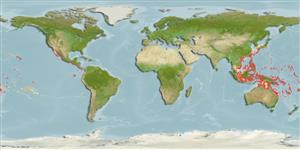>
Acropomatiformes (Oceanic basses) >
Pempheridae (Sweepers)
Etymology: Pempheris: Greek, pempheris = the name of a fish (Ref. 45335).
Eponymy: H Schwenk was a Major of Infantry in the Dutch East Indies who, we believe, collected the type and sent it to Pieter Bleeker. (Ref. 128868), visit book page.
More on author: Bleeker.
Issue
Distribution of this species is considered to be in the Indian Ocean and the Red Sea by Randall et al., 2014 (Ref. 95583), while Pacific Ocean by Koeda et al., 2014 (Ref. 95675).
Environment: milieu / climate zone / depth range / distribution range
Écologie
marin récifal; profondeur 5 - 40 m (Ref. 9710). Tropical
Pacific Ocean. Allopatric with sister species Pempheris tominagai which is widely distributed in the Indian Ocean and the Red Sea.
Taille / Poids / Âge
Maturity: Lm ? range ? - ? cm
Max length : 15.0 cm TL mâle / non sexé; (Ref. 2334)
Épines dorsales (Total) : 6 - 7; Rayons mous dorsaux (Total) : 9 - 10; Épines anales: 3; Rayons mous anaux: 35 - 42; Vertèbres: 25. This species is characterized by the following: 3.5 scale rows above lateral line; usually pinkish caudal fin in fresh specimens; posterior nostril usually compressed (Ref. 95675).
Inhabits rocky and coral reefs (Ref. 9710). Found hiding in caves during the day and feeding on zooplankton at night. Solitary or in small groups (Ref. 48636).
Life cycle and mating behavior
Maturité | Reproduction | Frai | Œufs | Fécondité | Larves
Randall, J.E., G.R. Allen and R.C. Steene, 1990. Fishes of the Great Barrier Reef and Coral Sea. University of Hawaii Press, Honolulu, Hawaii. 506 p. (Ref. 2334)
Statut dans la liste rouge de l'IUCN (Ref. 130435: Version 2024-1)
Menace pour l'homme
Harmless
Utilisations par l'homme
Outils
Articles particuliers
Télécharger en XML
Sources Internet
Estimates based on models
Preferred temperature (Ref.
123201): 24.4 - 29, mean 27.9 °C (based on 490 cells).
Phylogenetic diversity index (Ref.
82804): PD
50 = 0.5000 [Uniqueness, from 0.5 = low to 2.0 = high].
Bayesian length-weight: a=0.01380 (0.00591 - 0.03225), b=3.02 (2.83 - 3.21), in cm total length, based on LWR estimates for this Genus-body shape (Ref.
93245).
Niveau trophique (Ref.
69278): 3.4 ±0.45 se; based on food items.
Résilience (Ref.
120179): Haut, temps minimum de doublement de population inférieur à 15 mois (Preliminary K or Fecundity.).
Fishing Vulnerability (Ref.
59153): Low vulnerability (10 of 100).
Nutrients (Ref.
124155): Calcium = 92.8 [46.8, 142.1] mg/100g; Iron = 0.797 [0.472, 1.311] mg/100g; Protein = 18.4 [17.2, 19.5] %; Omega3 = 0.12 [0.07, 0.20] g/100g; Selenium = 26.6 [13.8, 51.8] μg/100g; VitaminA = 118 [36, 386] μg/100g; Zinc = 1.29 [0.86, 1.84] mg/100g (wet weight);
